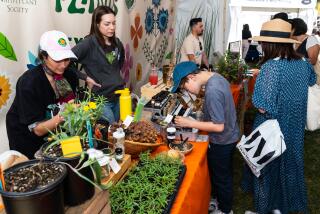Holidays Bring Out Best in Sasanqua Camellias
- Share via
If you’d like your outdoors colorful and decorative this holiday season, plant C. Sasanqua. These camellias are now in bloom and come in many colors, including a variety known as ‘Yuletide,’ which has bright red flowers.
“Unlike other types of camellias, which require shady conditions, Sasanqua camellias can handle any exposure and actually bloom more in full sun,” says Vince Hakes, owner of Huntington Garden Center in Huntington Beach.
Sasanqua camellias come in 1- and 5-gallon containers and will grow from 3 to 8 feet high and 4 to 5 feet wide, with a small number hitting the 15-foot range.
Some Sasanqua camellias are upright growers, others spread, and some tend to cascade, making good hanging basket plants.
Besides ‘Yuletide,’ an upright grower with small, single flowers, there are many other varieties of Sasanqua camellias to choose from.
‘Setsugekka’ is upright and bushy with large, white, semidouble flowers. ‘Apple Blossom’ is a spreading plant with large, single blooms that have white petals with pink or red edges. Chansonette cascades and makes a good hanging basket plant. It has large, pink double flowers.
To successfully grow Sasanqua camellias in your garden, keep the following suggestions in mind:
* If you receive a camellia as a gift, don’t keep the plant indoors for more than 10 days, because it will suffer from the dry, warm air.
* Camellias require well-drained soil high in organic matter. When planting in the ground, amend the soil by at least 20% with an azalea/camellia planting mix or other acid planting mix.
* Camellias make excellent container plants. Plant gallon-size camellias in 12- to 14-inch pots and 5-gallon ones in 16- to 18-inch containers. Use a potting soil high in organic matter or an acidic planting mix.
* Plant camellias so the trunk base is above the soil line, and always keep this base clear of debris and soil.
* Maintain the roots at an even temperature year-round by mulching with a 2-inch-thick mulch of homemade or bagged compost.
* Fertilize monthly when not in bloom with an acidic plant food. Fertilizing when in bloom is not necessary, because camellias bloom on stored-up energy. Over-fertilizing can lead to burned leaf edges, excessive leaf drop and spotting on leaves.
* Camellias are shallow-rooted and need to be well-watered but should never be soggy. Water camellias when the soil has just reached the dry side. Thoroughly soak the soil.
* Watch for aphids on new growth when the weather warms in the spring. Treat with a strong blast of water or insecticidal soap.
* Avoid camellia petal blight, a disease that causes flowers to rapidly turn brown, by keeping the ground clear of dropped leaves and flower heads. If the plant has petal blight, remove all affected flowers and any mulch and dispose of it all in a covered trash bin.
* Prune camellias right after they finish flowering to whatever shape you desire. Make sure to remove dead or diseased wood and to thin where branches are closely spaced. Encourage upright growth by pruning lower branches.
(BEGIN TEXT OF INFOBOX / INFOGRAPHIC)
DECEMBER PLANTING LIST
Although you may be preoccupied with the holidays, you don’t need to neglect your garden. A number of plants can be put in the ground this month.
Because of the short amount of daylight this time of year, seeds will take longer to germinate than it says on the seed packet. If you don’t want to wait, it’s best to plant transplants whenever possible.
FLOWERS
African daisy
Alyssum
Armeria (sea pink)
Calendula
Candytuft
Carnation
Cyclamen
Delphinium
English daisy
Foxglove
Gaillardia
Hollyhock
Iceland poppy
Larkspur
Nasturtium
Pansy
Penstemon
Poinsettia
Primula
Santa Barbara daisy
Snapdragon
Society garlic
Stock
Sweet Pea
Viola
Wildflowers
VEGETABLES
Artichoke
Arugula
Asparagus
Beet
Broccoli
Brussels sprout
Cabbage
Carrot
Cauliflower
Celery
Collards
Endive
Garlic
Kale
Kohlrabi
Leek
Lettuce
Mustard green
Onion
Parsley
Parsnip
Peas
Radish
Rhubarb
Rutabaga
Potato
Salsify
Spinach
Strawberry
Swiss chard
Turnip
TREES & SHRUBS
Australian fuchsia
Australian tea tree
Azalea
Blue hibiscus
Camellias ( C. Sasanqua )
Cape mallow
Flowering maple
Westringia
BULBS
Amaryllis
Anemone
Calla lily
Canna
Crocus (chilled 8 weeks)
Daffodil
Dutch iris
Freesia
Gladiolus
Grape hyacinth
Hyacinth (chilled 8 weeks) lily
Narcissus
Ranunculus
Tigridia
Tulip (chilled 8 weeks)
Watsonia
More to Read
Sign up for The Wild
We’ll help you find the best places to hike, bike and run, as well as the perfect silent spots for meditation and yoga.
You may occasionally receive promotional content from the Los Angeles Times.






